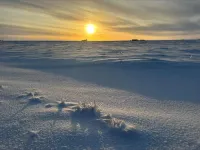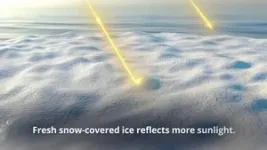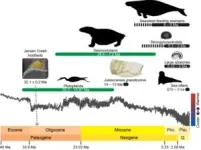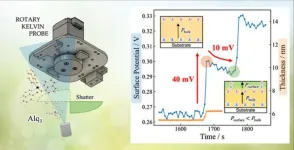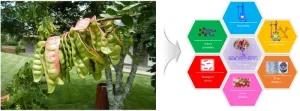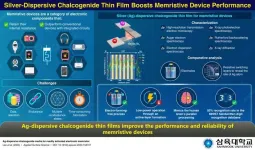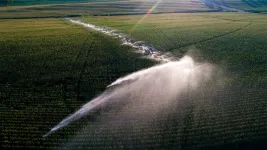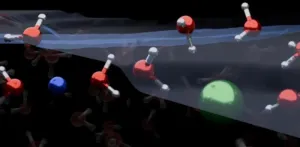(Press-News.org) ALBUQUERQUE, N.M. — The Arctic, Earth’s icy crown, is experiencing a climate crisis like no other. It’s heating up at a furious pace — four times faster than the rest of our planet. Researchers at Sandia National Laboratories are pulling back the curtain on the reduction of sunlight reflectivity, or albedo, which is supercharging the Arctic’s warming.
The scientists are not armed with parkas and shovels. Instead, they have tapped into data from GPS satellite radiometers, capturing the sunlight bouncing off the Arctic. This data dive could be the key to cracking the Arctic amplification code.
“The uneven warming in the Arctic is both a scientific curiosity and a pressing concern, leading us to question why this landscape has been changing so dramatically,” said Erika Roesler, an atmospheric and climate scientist at Sandia.
Previous studies have suggested that sea-ice albedo feedbacks are likely driving Arctic amplification. These albedo feedbacks can be broken down into two main areas. First, there’s an overall reduction in sea ice, leading to more exposure of the dark ocean. This absorbs more sunlight than snow-covered ice and raises temperatures. The second factor is the reflectivity of the remaining sea ice, or local albedo, which includes ponding water on ice due to melting.
Sandia researchers aimed to gain a better understanding of the reduction in reflectivity in the Arctic. Senior scientist Phil Dreike collaborated with the U.S. Space Force to obtain permission for Sandia to analyze previously unpublished data from the radiometers on GPS satellites.
“New observational climate datasets are unique," Roesler said. "To qualify as a climate dataset, observations must span a multitude of years. Small-scale science projects are typically not that long in duration, making this dataset particularly valuable."
Amy Kaczmarowski, an engineer at Sandia, conducted an analysis of the data spanning from 2014 to 2019.
“There have been numerous local measurements and theoretical discussions regarding the effects of water puddling on ice albedo," Kaczmarowski said. "This study represents one of the first comprehensive examinations of year-to-year effects in the Arctic region. Sandia’s data analysis revealed a 20% to 35% decrease in total reflectivity over the Arctic summer. According to microwave sea-ice extent measurements collected during the same period, one-third of this loss of reflectivity is attributed to fully melted ice.”
The other two-thirds of the loss in reflectivity is likely caused by the weathering of the remaining sea ice.
“The key discovery here is just how much the weathered ice is reducing reflectivity,” Kaczmarowski added. Weathered ice refers to the remaining sea ice, which can be thinner and may contain melt ponds.
The GPS satellites are expected to continue providing data through 2040. The Sandia team hopes other researchers will consider their findings, recently published in the journal Nature Scientific Reports, and incorporate them into their models for Arctic amplification. They plan to continue mining the GPS data and are enthusiastic about collaborating with other climate researchers for further analysis.
“We will continue to use this data to investigate various regions of the Earth for climate applications,” Kaczmarowski said.
Sandia National Laboratories is a multimission laboratory operated by National Technology and Engineering Solutions of Sandia LLC, a wholly owned subsidiary of Honeywell International Inc., for the U.S. Department of Energy’s National Nuclear Security Administration. Sandia Labs has major research and development responsibilities in nuclear deterrence, global security, defense, energy technologies and economic competitiveness, with main facilities in Albuquerque, New Mexico, and Livermore, California
Sandia news media contact: Kenny Vigil, kcvigi@sandia.gov, 505-537-1528
END
Chasing the light: Sandia study finds new clues about warming in the Arctic
Study focuses on reduction in sunlight reflectivity
2024-01-15
ELSE PRESS RELEASES FROM THIS DATE:
Physicists identify overlooked uncertainty in real-world experiments
2024-01-15
The equations that describe physical systems often assume that measurable features of the system — temperature or chemical potential, for example — can be known exactly. But the real world is messier than that, and uncertainty is unavoidable. Temperatures fluctuate, instruments malfunction, the environment interferes, and systems evolve over time.
The rules of statistical physics address the uncertainty about the state of a system that arises when that system interacts with its environment. But they’ve ...
Kessler Foundation receives grant to investigate impact of combining aerobic exercise and virtual reality for individuals with multiple sclerosis
2024-01-15
East Hanover, NJ – January 15, 2024 – Kessler Foundation received a $39,994 grant from the Consortium of Multiple Sclerosis Centers to investigate the impact of a unique combination of a single bout of aerobic cycling and virtual reality (VR) on processing speed in persons with multiple sclerosis (MS) and mobility disability.
Processing speed is the most common cognitive problem in persons with MS and may actually contribute to broader cognitive difficulties, according to the grant recipient, Carly Wender, PhD, research scientist in the Center for Neuropsychology ...
The power of pause: Controlled deposition for effective and long-lasting organic devices
2024-01-15
Organic optoelectronic devices, such as organic light-emitting diodes (OLEDs), use molecules with specific structures arranged on thin films. Additionally, the arrangement of these molecules on any surface is crucial for various processes that occur within these devices. This arrangement is guided by two primary factors: the deposition rate (how fast the molecules are placed) and the surface temperature. Slower deposition rates and higher temperatures facilitate the proper arrangement, resulting in more stable structures. Finding the right time scale for this process is also critical, and ...
Going beyond plastic: Chung-Ang University team explores tara gum as a green polymer
2024-01-15
Synthetic, non-biodegradable plastics are major sources of environmental pollution and have prompted a rising interest in sustainable, biodegradable alternatives derived from natural polymers. “Tara gum,” derived from the seeds of the tara tree (Caesalpinia spinosa), stands out as a promising solution. This natural, water-soluble substance contains polysaccharides (complex carbohydrates), including the widely used “galactomannan,” which is employed in coatings, edible films, and as a stabilizer and thickener. The biocompatibility, biodegradability, and safety of tara gum also make it valuable in industries like food and drug delivery. ...
Sahmyook University researchers open doors to next-generation memristive devices
2024-01-15
Memristive devices constitute a category of devices capable of retaining their internal resistance, thus offering superior performance compared to conventional devices that use integrated circuits. Several materials have been explored to manufacture these devices. In recent years, transition metal oxides have gradually become widely popular for this purpose.
Due to their increasing application in diverse domains like artificial intelligence systems, memristive devices must now overcome several issues related to data retention, endurance, and a large number of conductance states. Moreover, the individual fabrication ...
Study quantifies how aquifer depletion threatens crop yields
2024-01-15
Three decades of data have informed a new Nebraska-led study that shows how the depletion of groundwater — the same that many farmers rely on for irrigation — can threaten food production amid drought and drier climes.
The study found that, due in part to the challenges of extracting groundwater, an aquifer’s depletion can curb crop yields even when it appears saturated enough to continue meeting the demands of irrigation. Those agricultural losses escalate as an aquifer dwindles, the researchers reported, so that its ...
When bees nourish their microbiota
2024-01-15
Two teams from UNIL and EPFL have succeeded in demonstrating that the insect synthesizes nutrients for native gut microbes. A study published in « Nature Microbiology ».
Bacteria have adapted to all terrestrial environments. Some have evolved to survive in the gut of animals, where they play an important role for their host; they provide energy by degrading indigestible food, they train and regulate the immune system, they protect against invasion by pathogenic bacteria, and they synthesize neuroactive molecules that regulate the behavior and cognition of their host.
These are great ...
Accelerating how new drugs are made with machine learning
2024-01-15
Researchers have developed a platform that combines automated experiments with AI to predict how chemicals will react with one another, which could accelerate the design process for new drugs.
Predicting how molecules will react is vital for the discovery and manufacture of new pharmaceuticals, but historically this has been a trial-and-error process, and the reactions often fail. To predict how molecules will react, chemists usually simulate electrons and atoms in simplified models, a process which is computationally expensive and often inaccurate.
Now, researchers from the University of Cambridge ...
Water molecule discovery contradicts textbook models
2024-01-15
Textbook models will need to be re-drawn after a team of researchers found that water molecules at the surface of salt water are organised differently than previously thought.
Many important reactions related to climate and environmental processes take place where water molecules interface with air. For example, the evaporation of ocean water plays an important role in atmospheric chemistry and climate science. Understanding these reactions is crucial to efforts to mitigate the human effect on our planet.
The distribution of ions at the interface of air and water can affect atmospheric processes. However, a precise understanding of ...
U.S. air pollution rates on the decline but pockets of inequities remain
2024-01-15
Over the last decades, air pollution emissions have decreased substantially; however, the magnitude of the change varies by demographics, according to a new study by Columbia University Mailman School of Public Health. The results indicate there are racial/ethnic and socioeconomic disparities in air pollution emissions reductions, particularly in the industry and energy generation sectors. The findings are published in the journal Nature Communications.
The research provides a national investigation of air pollution emission changes in the 40 years following the enactment of the Clean Air ...
LAST 30 PRESS RELEASES:
Manta rays create mobile ecosystems, study finds
Study: Mixed results in using lipoic acid to treat progressive multiple sclerosis
Norbert Holtkamp appointed director of Fermi National Accelerator Laboratory
New agentic AI platform accelerates advanced optics design
Biologists discover neurons use physical signals — not electricity — to stabilize communication
Researchers discover that a hormone can access the brain by hitchhiking
University of Oklahoma researcher awarded funding to pursue AI-powered material design
Exploring how the visual system recovers following injury
Support for parents with infants at pediatric check-ups leads to better reading and math skills in elementary school
Kids’ behavioral health is a growing share of family health costs
Day & night: Cancer disrupts the brain’s natural rhythm
COVID-19 vaccination significantly reduces risk to pregnant women and baby
The role of vaccination in maternal and perinatal outcomes associated with COVID-19 in pregnancy
Mayo Clinic smartwatch system helps parents shorten and defuse children's severe tantrums early
Behavioral health spending spikes to 40% of all children’s health expenditures, nearly doubling in a decade
Digital cognitive behavioral treatment for generalized anxiety disorder
Expenditures for pediatric behavioral health care over time and estimated family financial burden
Air conditioning in nursing homes and mortality during extreme heat
The Alps to lose a record number of glaciers in the next decade
What makes a good proton conductor?
New science reporting guide published for journalists in Bulgaria
New international study reveals major survival gaps among children with cancer
New science reporting guide published for journalists in Turkey
Scientists develop a smarter mRNA therapy that knows which cells to target
Neuroanatomy-informed brain–machine hybrid intelligence for robust acoustic target detection
Eight SwRI hydrogen projects funded by ENERGYWERX
The Lundquist Institute and its start-up company Vitalex Biosciences Announces Strategic Advancement of Second-Generation fungal Vaccine VXV-01 through Phase 1 Trials under $40 Million Competitive Con
Fine particles in pollution are associated with early signs of autoimmune disease
Review article | Towards a Global Ground-Based Earth Observatory (GGBEO): Leveraging existing systems and networks
Penn and UMich create world’s smallest programmable, autonomous robots
[Press-News.org] Chasing the light: Sandia study finds new clues about warming in the ArcticStudy focuses on reduction in sunlight reflectivity
